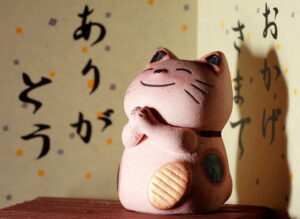In Japanese, “どうも” (doumo) is a very versatile and frequently used word that can mean a few different things depending on the context. どうも, pronounced “Dou-mo,” is a phrase you’d come across when you eating in at an Izakaya or a restaurant. Domo is equivalent to the English version of “very much” and “very”. In many situations, the word is used to express appreciation.
In this post, we’ll break down the meanings of doumo, explain when and how to use it, and give you real-life examples to help you sound more natural when speaking Japanese.
What Does “Domo” Mean in Japanese?
In Japanese, どうも (doumo) is a flexible and commonly used word that can express gratitude, serve as a greeting, emphasize an apology, or convey uncertainty. Its meaning changes depending on context, tone, and the words it’s paired with. While often translated as “thanks” or “very,” it has a much broader range of use in real-life conversation.
1. Domo as “Thank You”
One of the most frequent uses of doumo is to express gratitude. It can be used on its own to casually say “thanks,” or combined with other expressions to show more formality. For example, どうもありがとう means “thank you very much,” while どうもありがとうございます is an even more polite and respectful version. Saying just どうも by itself is common among friends or acquaintances when you want to thank someone casually, such as when receiving a small favor or gift.
Tip: Adding doumo makes your thank-you sound warmer and more polite.
2. Domo as a Greeting
In casual situations, doumo can also be used as a brief, informal greeting, similar to saying “hi” or “hey” in English. You might hear someone say どうも〜 when they run into a coworker or friend. It’s short, friendly, and relaxed, but it’s not appropriate in formal or professional introductions.
3. Domo in Apologies
Doumo can soften the tone of an apology when paired with expressions like すみません (sumimasen) or 失礼しました (shitsurei shimashita). Phrases like どうもすみません or どうも失礼しました convey a stronger sense of sincerity—roughly translating to “I’m really sorry” or “I truly apologize.” In this context, doumo works as an intensifier, adding politeness and humility to the apology.
4. Domo to Show Uncertainty or Emphasis
Another function of doumo is to express vague feelings or emphasize a state of uncertainty. It often appears in phrases like どうも変だね (“That seems weird”) or どうも調子が悪い (“Something feels off”). In these cases, it communicates a sense of something being unclear, wrong, or difficult to explain. It’s often used when the speaker can’t quite put their finger on the issue.

“Arigato Neko” by jpmatth is licensed under CC BY-NC-ND 2.0
If you know Japan, you have probably come across the phrase “Arigato” at some point. If you’re a foreigner traveling to Japan, “Arigato” is a phrase you cannot avoid using. On the other hand, Domo is a much shorter way of saying Arigato.
Let’s say that you’re leaving the restaurant with your friend. A conversation between you and the shopkeeper could sound like this:
You: ごちそうさまでした。
It was very delicous.Shop-keeper: どうもありがとうございました。
Thank you for eating at our place.You: どうも。
Domo.

“Izakaya in Shibuya” by fakelvis is licensed under CC BY-SA 2.0
What’s useful about Domo is that it can have different meanings in certain situations. It can mean “hello” when you arrive and “bye” when you leave.
The phrase also has a negative connotation. It is used when you want to sincerely apologize to someone. The direct translation of this word is “very” in the same context as “I’m very sorry”. In Japan, people often use this word towards a stranger or a superior. If you bump into someone by accident, it is appropriate to say:
You: どうもすみません!
I’m very sorry!
What’s an interesting fact about “Domo”?
In Japan, mascot characters are created to represent many companies and regions. In fact, Japan has a “Domo-kun(どーもくん)” mascot. He is an official mascot created by Japan’s public broadcast (NHK). His concept derives from the greetings in Japanese morning television.

“Mascot Convention” by Jeffrey Beall is licensed under CC BY-ND 2.0
When (and When Not) to Use Domo
| Expression | Meaning | Context |
|---|---|---|
| どうも | Thanks / Hi | Very casual |
| どうもありがとう | Thank you very much | Casual but polite |
| どうもありがとうございます | Thank you very much (formal) | Formal, respectful |
| どうもすみません | I’m very sorry | Polite apology |
| どうも調子が悪い | I don’t feel right | Expressing uncertainty |
| あ、どうも〜 | Hey there! | Casual greeting |
Doumo is safe to use in casual and semi-formal situations, especially when you’re talking with people you know well. It’s great for friendly conversations, everyday gratitude, and casual greetings. However, in formal situations, such as business meetings or speaking with someone older or of higher status, you should avoid using doumo alone. Instead, use full expressions like ありがとうございます (thank you) or 失礼しました (excuse me).
Examples of Using Domo in Japanese
To help you better understand how どうも (doumo) is used in real life, here are several example sentences across different situations, each with an English translation and short explanation.
Example 1:
Japanese:
A: これ、落としましたよ。
B: あ、どうも!
English:
A: You dropped this.
B: Oh, thanks!
Example 2:
Japanese:
ご来店いただき、どうもありがとうございます。
English:
Thank you very much for visiting our store.
Want to master Japanese? Start taking Japanese lessons with us!
Download our free hiragana chart & practice sheet, or explore our courses for beginner and intermediate learners. With Coto Academy, you’ll learn how to use real Japanese the way people actually speak it.
